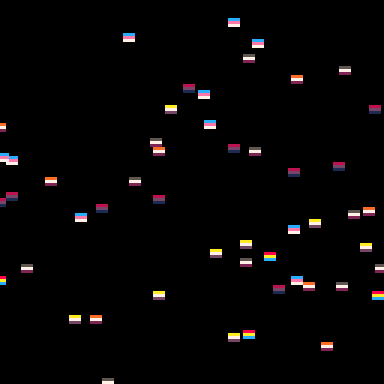PICO-8 Tweetcart Studies
Pride Flags
Author: Daniel Oaks (@pixienop)
Link: https://twitter.com/pixienop/status/1271731359032111105

Display Palette
Summary
This is a pretty cute cart that draws a bunch of flags on the screen! It stores the flag colours in a string, then extracts each colour using ord() (props to @beanborg for pointing me to that function).
Instead of cls(), it writes a random number of black pixels all over the screen, which creates this interesting dithered trail behind each flag. See the cls-vs-dithering page for some more info on this.
Pictures

The same effect with a cls() instead of the random-black-pixels bg clearing.

The same effect with a flag string of 111222333444555666
Tweet code
pal({8,10,12,136,141,1,5,14,7,137,2},1)n=rnd
f="123456389:9;29579;"::w::r=t()
srand(r)for i=0,3300 do pset(n(128),n(128),0)end
srand()for j=0,70 do
y=n(120)+sin(r/3+n())*8k=n(6)\1*3x=(n(200)-r*n(50))%200-3for i=1,3 do
line(x,i+y,x+3,i+y,ord(f,k+i))end
end
flip()goto wBreakdown
-- setup display palette
pal({8,10,12,136,141,1,5,14,7,137,2},1)
-- flags - each three characters is a flag.
--
-- e.g. 123 are the first three chars on the screen,
-- which here is the pan flag (red,yellow,blue).
-- the : and ; are actually 10 and 11 - you can see this
-- if you do 'print(chr(*))' with 57, 58, 59, or just
-- check out an ascii chart.
f="123456389:9;29579;"
-- start of rendering loop
::w::
-- dithered pixely fade-out. could do a cls() instead,
-- but this looks pretty!
srand(t())
for i=0,3300 do
pset(rnd(128),rnd(128),0)
end
-- seed rnd() calls to a consistent set of values, so
-- each frame all the following rnd() calls will return
-- the same values
srand()
-- 70 flags
for j=0,70 do
-- selecting which flag to use.
-- rnd(6)\1 is equivalent to flr(rnd(6)) .
-- and *3 because there's three colours in each flag
k=rnd(6)\1*3
-- simple up/down sin wave for the flag's height
y=rnd(120)+sin(t()/3+rnd())*8
-- x position of the flag.
-- rnd(200) gives us our starting position.
-- -t()*rnd(50) adjusts the speed of each flag.
-- %200 wraps the flags back around to just past the
-- right side of the screen when it hits the left.
-- -3 so that the wrapping up there isn't visible, and
-- only happens once the flag is not visible anymore
x=(rnd(200)-t()*rnd(50))%200-3
-- 3 stripes in each flag
for i=1,3 do
-- where the magic happens! so, the flag string is
-- 'f', and 'k+i' is the index of the specific
-- colour we want to grab out of it.
-- normally, we would do ord(f,k+i)-chr('0') ,
-- to zero out the returned character, but since
-- pico8's colours keep wrapping, and chr('0') is a
-- multiple of 16, we don't actually need to! :D
line(x,i+y,x+3,i+y,ord(f,k+i))
end
end
-- display this frame to the screen. if we didn't use
-- flip here, pico-8 would just grab new frames
-- whenever, even if they're not finished yet
flip()
goto w